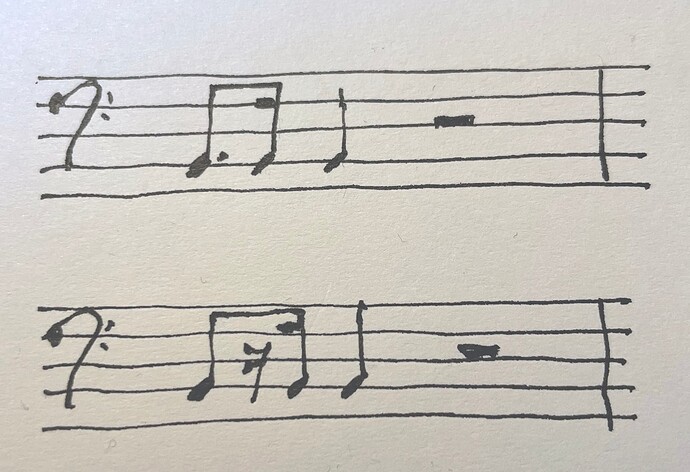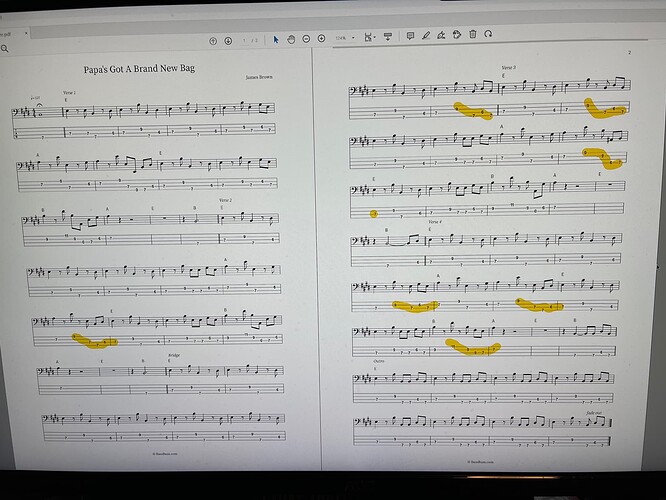Well…
There are a lot of tricks in the bag that I am identifying and then actually remembering to use.
Here are some things I do
First and foremost…
Listen to the song! Your memory of the song is not what you think!
Try to listen to the bassline (even with this you will be suprised how much of it you get wrong (thus, bad tabs on the interweb).
Like cooking when they tell you to read the entire recipe before you start, read the entire sheet music/tab before you start. Make notes, find ‘mileposts’ (verse, chorus, bridge, outro, etc)
Buy the song and put it in a slow downer app, I use AnyTune Pro+, but AmazingSlowDowner works too, I am used to the AnyTune Pro+ interface so I tend to just use it.
Put those mileposts above in the tune in the app.
Also put the song in an AI splitter like Moisies, etc.
Listen to the song again, with the bass part turned up and the rest turned down a bit, you will be suprised how different the bass line really is from what you think it is sometimes.
Papa’s Got A Brand New Bag is a very good example of this. When I first started learning this, the bassline felt like the beat of the melody, but it isn’t even close. But once you hear and feel the real bassline, it can’t be unheard.
So the above tools help me learn the song quicker.
I start by playing through the tune and identifying what seems easy and what seems hard.
I highlight in the sheet music the tricky bits.
Also put marks around tricky bits in the slow down app, for ease of moving the repeat loop later.
Now I start from the beginning at a slow speed, all depends on the tune and how far away I am, maybe 80% or 75%. I had to start “About Damn Time” at about 65%.
FEEL the bass line at these speeds.
Embed the groove in you and your playing and don’t speed up when you know the section, speed up when you play it with the right feel only (like @joergkutter mentioned, this is really important).
When I hit the first tricky part, that is where I stop and embed the tune to that point only.
I put the repeat around the tricky part, and play it over and over slowly.
This is also important, once you get it, feel how it feels in your fingers, where they go, how they have to move. Close your eyes and play it, or, if you have to, stare at the fretboard to play it, BUT…know what comes next and before the tricky bit.
Once you have the tricky bit down, add a bar or two in front of it to ‘pick it up’ and the next bar or two to know where you are going.
Then speed this part up to full speed, but not the whole song, yet.
If you don’t plan on memorizing the entire song, then memorize enough after any time you have to stare at the fretboard for a tricky bit that you can play on autopilot as you go look up back at the sheetmusic and find your place. The highlights I make help me lock into where i was.
Here is a score that I highlighted the tricky bits on:
Why are they tricky?
They are slight changes to both notes and rests in repeated riffs.
Now, you could play them all the same, but that is not the ‘feel’ of the tune.
So when I go to record this, I have a visual cue of what the tricky bit is.
A rest instead of a note, change in notes, etc.
Also notice the big rests in the tune - these are important.
They give you a ‘ok, cool, made it here, take a breath, next bit’.
If you want to memorize the entire song, a trick I use is this …
Use the lyrics around tricky parts and changes in riffs as your audible guideposts. Or chord changes or drums, anything to signal you.
When Lizzo sings:
Feeling fussy, walkin’ in my Balenci-ussy’s (I made a note in my mind that a slide was coming up)
Tryna bring out the fabulous
'Cause I give a fuck way too much
I’ma need like two shots in my cup
One to get up, one to get down (the word up starts a slide from the E string fret 8 to 10 to 0.)
As you start learning the song, pick things that stand out to you audibly as ‘milestones’
The above is a good example. After the slide part, I knew the ‘second riff’ comes back, for example.
So once I learn a song chunck to a point, and have the feel and notes down, I keep going until I hit another ‘tricky bit’, and repeat the above.
Take breaks!
Lunch, a snack, a night’s sleep.
If you start going downhill, stop.
Sometimes even a bathroom break or sip or water will work.
Let your brain do its thang.
Other things I do:
- Sit down sometimes and try to play the song or just parts with no music in front of you.
- Play with the backing track on and off.
- Play with the original bassline in and out.
- Learn the end! - The end of the song is the part you practice the least, hangs me up the most, learn it first or early on.
- Put your phone in Do Not Disturb Mode - I have one set up for practice that only allows certain things to interrupt
- Don’t be beholden to the tab! - It is one person’s interpretation of the way to play it. On About Damn Time i used a 4 string instead of a 5er like Lizzo’s bassist does cause it didn’t make sense to my fingers, I detuned a half step instead. - I also did not like where most online were playing it, so dropped it a string and moved it up the fretboard. Find what works.
When you have the whole song slow and nailed, inch it up (in my app it is in 5% speed increments) and play it until you can nail the tricky bits, then advance. Maybe play a few more times once nailed before moving on.
I know this seems like a lot but it gets me there faster in the end, and the more I do it the faster it goes.
I memorized About Damn Time, mainly because I wanted to.
But more often than not, I play to a shorthand vs. the score.
I might write out the structure or signals to the tricky bit parts on a sheet of paper.
Not Verse / Chorus / Verse, but rather something like this (From On A Clear Day):
The thing about this song is it is very repetitive with chord changes occuring at different times. Instead of memorizing all that, this guide gives me the ‘what’s next and where to go’. Like a road map.
Take the first three lines:
The riff starts on 78 of the A string and ends on the 8th fret of (I think) the D string, does that twice, then replaces the last note with the 7th fret and repeats 10x.
Then the riff moves to starting on the 9/10 frets of the E twice.
Next section - riff drops down the E string and bounces around a bit.
Etc
Make sense? If not, its fine, it doesn’t have to. Write down what works for you.
Why memorize the entire thing in your head if you don’t need to go perform it over and over again?
I know this looks like a lot, but it honestly isn’t, and most importantly, takes the struggle out of learning a song.
Some other tips:
If a song is too hard, don’t fight it - learn a bit of it (poorly) and come back to it here and there until it ‘magically’ seems easier.
Feeling down, pick a simple song to boost your confidence.
RECORDING -
Sometimes I will use the waveform to follow along vs. sheet music, and add in cues for section changes like this (Abelton, but all can do this)…
VIDEO -
If you panic of freeze up when you record, record the song without video, make the video after (you will be suprised at how much more relaxed you are). You still have to play it right otherwise it is obvious, and there isn’t a pro in the world that hasn’t done this.
If you really want to memorize and do ‘one take’, then do your thing.
I do a mix of both, depending.
MISTAKES -
If I record a video and get a 98% fab-o take and there is one or two dopey mistakes, I will overdub that bit in the DAW with a puch in/out.
Cheating? Who cares?
People playing live make mistakes all day every day, no one notices.
People staring at you on youtube notice every mistake.
More than 1 or two, I do a retake until right.
Or, if the mistakes aren’t too bad (throw off the groove, etc) - I leave them in.
That said, most songs I try to get a clean take 100% right or darn close to it.
What is the use of toiling for an extra hour or two or day or two to get a single clean take that is 100% accurate?
If you are just starting out, go find SIMPLE songs to memorize, even if you don’t like them, and a good resource to learn them from. Don’t go big to start out. I can’t tell you how many times I played “Babe” by Styx in the very beginning, simply becuase I could pay the whole song.
Anyway, these tools work well for me and are working better all the time.
I use some or all when needed, no hard rules, whatever works.
Hope this helps someone.









 )
)